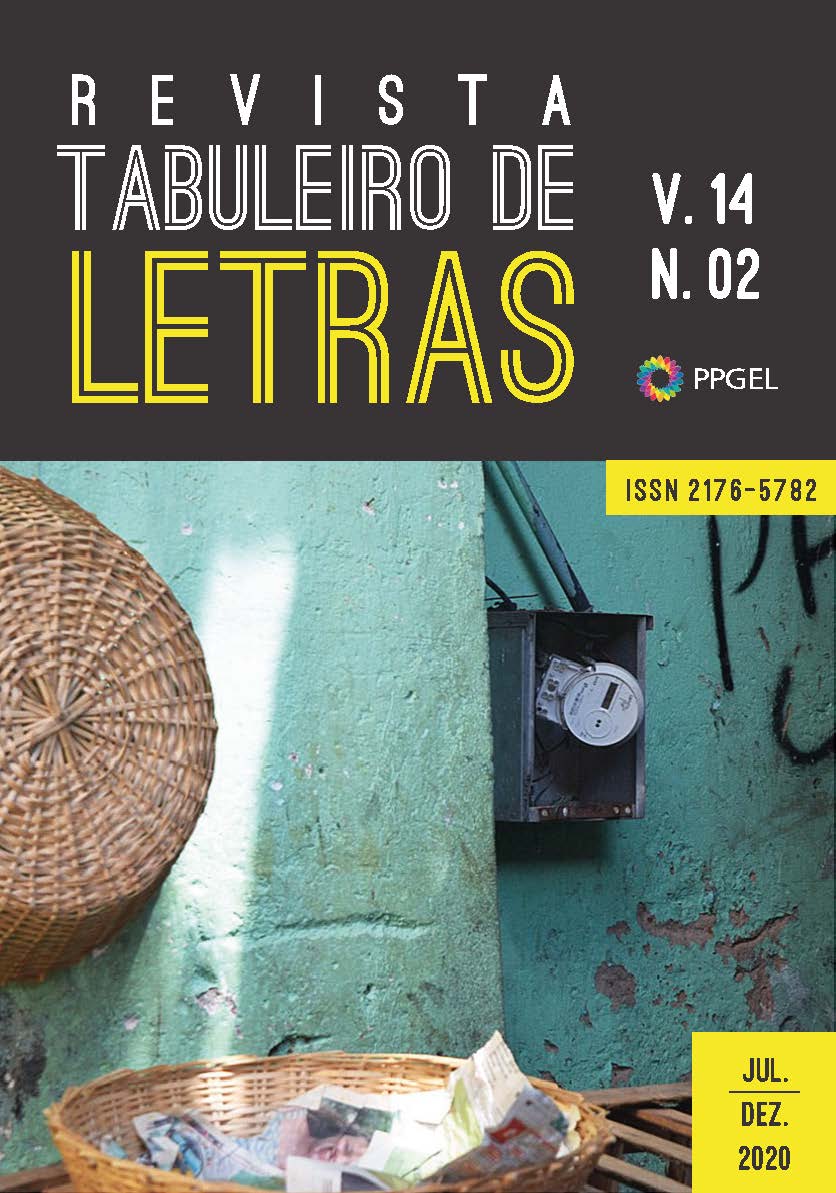Impessolização e indeterminação: um estudo da construção verbo (semi) auxiliar + pronome SE + verbo principal
DOI:
https://doi.org/10.35499/tl.v14i2.8826Keywords:
Pronome se, indeterminação, impessoalização.Abstract
This study has as main objective to analyze the uses of the construction with (semi-) auxiliary verb + pronoun SE + main verb in scientific and academic texts of Brazilian Portuguese. It is assumed that it can be used to promote impersonalization or indeterminacy. The initial hypothesis of the research is that in scientific texts, the construction would be more used to promote the defocusing of the discursive first person, while, in the journalistic texts, it would be more used to remove the third discursive person from the sce-ne. Theoretical assumptions of the socioconstructionist theories (MACHADO VIEIRA, 2017; MACHADO VIEIRA; WIEDEMER, 2018), constructionist and cognitivist (CROFT, 2001; DIESSEL 2015; FILLMORE, 1988; GOLDBERG, 1995, 2006; HOPPER, 1991) matter for this study.
Downloads
References
FILLMORE, Charles J.; KAY, Paul.; O’CONNOR, Mary C. Regularity and idiomaticity in grammatical constructions: the case of let alone. In.: Language, 64, 3, p. 501-538, 1988.
GOLDBERG, Adele E. Constructions: a construction grammar approach to argument structure. Chicago and London: The University Chicago Press, 1995.
__________. Constructions at work. Oxford: Ox-ford University Press, 2006.
HOPPER, P. On some principles of grammatica-zation. In: TRAUGOTT, Elizabeth & HEINE, Bernd. Approaches to grammaticalization, v.1 Amsterdan: Benjamins, p. 17-37, 1991.
MACHADO VIEIRA, Marcia. S; WIEDEMER, Marcos L. Lexemas e construção: atração, coerção e variação” In.: Caderno Seminal Digital. Rio de Janeiro, v. 30, p. 81-132, 2018. Disponível em: <> Acesso em: 15 de março de 2020.
MACHADO VIEIRA, Marcia S. Expressões impessoais no discurso acadêmico brasileiro. In.: Revista Letrônica. Porto Alegre, v. 10, n. 1, p. 82-95, jan-jun 2017. Disponível em: <http://revistaseletronicas.pucrs.br/ojs/index.php/le-tronica/article/view/25061> Acesso em: 30 de março de 2020.
MORAIS, Fernanda B.C. Os Usos do Clítico ‘Se’ em Artigos Científicos: mecanismos de impessoalização na escrita acadêmica. In.: SIGNUM: Estudos Linguísticos, Londrina, n. 20, p. 241-275, 2017. Disponível em: < http://www.uel. br/revistas/uel/index.php/signum/article/view/22980> Acesso em: 18 de março de 2020.
REIS, Fernanda E. B. Auxiliaridade no português brasileiro. In.: Língua, Literatura e ensino, Vol. III, p. 461-471, 2008. Disponível em.: <http://revistas.iel.unicamp.br/index.php/lle/article/view/97> Acesso em: 11 de março de 2020.
SHIBATANI, Masayoshi. Passives and related constructions: a prototype analysis. In.: Language, vol. 61, n. 4, p. 821-848, 1985. Disponível em: <https://www.researchgate.net/publica-tion/244437975_Passives_and_Related_Cons-tructions_A_Prototype_Analysis> Acesso em: 13 de março de 2020.
ização discurso de divulgação científica infan-to-juvenil: o emprego do pronome você. In.: IV Simpósio Internacional de Estudos de Gêne-ros Textuais, 2007, Tubarão. IV Siget, p. 1826-1838, 2007. Disponível em: Acesso em: 30 de fevereiro de 2020.
THOMPSON, Geoff. Voices in the text: Discourse perspectives on language reports. In.: Applied Linguistics, Vol 17, No 4 O Oxford University Press, p. 501-530, 1996. Disponível em:<http://www.isfla.org/Systemics/Print/Thompson/Thompson_1996_Voices_in_the_text.pdf> Acesso em: 29 de março de 2020.
VIEIRA, Lúcia M. O. Os modais “dever” e “poder” e o uso de verbos na forma imperativa na construção da argumentação da campanha “amigos da escola”. In.: Letras e Letras, Uberlândia, 18 n 2, p. 111-113, jul./dez. 2002. Disponível em: <http://www.seer.ufu.br/index.php/letrasele-tras/article/download/25137/13955/> Acesso em: 12 de março de 2020.
WEINREICH, Uriel.; LABOV, William & HERZOG, Marvin I. Empirical foundations for a theory of language change. In.: LEHMANN, Winfred P.; MALKIEL, Yakov. (eds.). Directions for historical linguistics. Austin: University of Texas Press, p. 95-195, 1968.
Downloads
Published
How to Cite
Issue
Section
License
Autor(es) conservam os direitos de autor e concedem à Revista o direito de primeira publicação, com o trabalho simultaneamente licenciado sob a Licença Creative Commons Attribution que permite a partilha do trabalho com reconhecimento da autoria e publicação inicial nesta Revista.

















